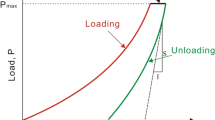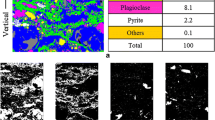Abstract
Natural rocks belong to the class of polymineral composite materials with complex microstructures. Such strong heterogeneity of rocks makes it difficult to estimate the effective moduli by traditional models in theory. In the present study, a Mori–Tanaka (MT) model considering the shape and orientation of inclusion minerals obtained by micro-computed tomography (micro-CT) is established, and then it is applied to evaluate the anisotropic parameters of shales. In the MT model, the principal radii and Eulerian angles of the ellipsoidal inclusion are obtained by solving its inertia matrix through micro-CT. According to this inclusion information, we determined the statistics on the ratio of average principal radii and the distribution of Eulerian angles of inclusions with different minerals. In what follows, the effective elastic stiffness matrix of shale samples is predicted by the MT model, and the corresponding digital core is input for finite element method (FEM) analysis to verify the accuracy of the theoretical results. It is shown that the anisotropy of the elastic stiffness matrix predicted by the MT model and FEM is consistent under two sizes of representative volume elements. These findings highlight the potential of this approach for applications in rock mechanics, civil engineering, and oil exploitation, among others.












Similar content being viewed by others
Data availability
The supporting information involved in this study is available within this article.
References
Asaka, M., Holt, R. M., & Bakk, A. (2021). Rock physics model of shale: predictive aspect. Journal of Geophysical Research-Solid Earth, 126(9), 1–26.
Berryman, J. G. (1995). Mixture Theories for Rock Properties. American Geophysical Union.
Cheng, C. H. (1993). Crack models for a transversely isotropic medium. Journal of Geophysical Research-Solid Earth, 98, 675–684.
David, E. C., & Zimmerman, R. W. (2011). Compressibility and shear compliance of spheroidal pores: Exact derivation via the Eshelby tensor, and asymptotic expressions in limiting cases. International Journal of Solids and Structures, 48, 680–686.
David, E. C., & Zimmerman, R. W. (2011). Elastic moduli of solids containing spheroidal pores. International Journal of Engineering Science, 49, 544–560.
Deng, J. X., Zhou, H., Wang, H., Zhao, J. G., & Wang, S. X. (2015). The influence of pore structure in reservoir sandstone on dispersion properties of elastic waves. Chinese Journal of Geophysics-Chinese edition, 58, 3389–3400.
Drach, B., Tsukrov, I., Gross, T., Dietrich, S., Weidenmann, K., Piat, R., & Bohlke, T. (2011). Numerical modeling of carbon/carbon composites with nanotextured matrix and 3D pores of irregular shapes. International Journal of Solids and Structures, 48(18), 2447–2457.
Drach, B., Drach, A., & Tsukrov, I. (2013). Characterization and statistical modeling of irregular porosity in carbon/carbon composites based on X-ray microtomography data. ZAMM-Zeitschrift fur Angewandte Mathematik und Mechanik, 93, 346–366.
Eshelby, J. D. (1957). The determination of the elastic field of an ellipsoidal inclusions, and related problems. Proceedings of the Royal Society of London, Series A: Mathematical and Physical Sciences, 241(1226), 376–396.
Giraud, A., Huynh, Q. V., Hoxha, D., & Kondo, D. (2007). Effective poroelastic properties of transversely isotropic rock-like composites with arbitrarily oriented ellipsoidal inclusions. Mechanics of Materials, 39, 1006–1024.
Goodarzi, M., Rouainia, M., & Aplin, A. C. (2016). Numerical evaluation of mean-field homogenization methods for predicting shale elastic response. Computers & Geosciences, 20(5), 1109–1122.
Gui, J. C., Ma, T. S., Chen, P., Yuan, H., & Guo, Z. (2018). Anisotropic damage to hard brittle with stress and hydration coupling. Energies, 11, 926–940.
Hudson, J. A. (1986). A higher order approximation to the wave propagation constants for a cracked solid. Geophysical Journal of the Royal Astronomical Society, 87, 265–274.
Jian, S. K., Fu, L. Y., Wang, Z. W., Han, T. C., & Liu, J. L. (2020). Elastic equivalent numerical modeling based on the dynamic method of Longmaxi Formation shale digital core. Chinese Journal of Geophysics-Chinese edition, 63(7), 2786–2799.
Mavko, G., Mukerji, T., & Dvorkin, J. (2020). The Rock Physics Handbook, Third Edition. Cambridge University Press.
Moon, J., Yoon, S., & Monteiro, P. J. (2015). Mechanical properties of jennite: a theoretical and experimental study. Cement and Concrete Research, 71, 106–114.
Mori, T., & Tanaka, K. (1974). Average stress in matrix and average elastic energy of materials with misfitting inclusions. Acta Metallurgica, 21(5), 571–574.
Park, I., Moon, J., Bae, S., Oh, J. E., & Yoon, S. (2020). Application of micro-CT to Mori-Tanaka method for non-randomly oriented pores in air-entrained cement pastes. Construction and Building Materials, 255, 119342.
Prasad, M., Pal–Bathija, A., Johnston, M., Rydzy, M., & Batzle, M. (2009). Rock physics of the unconventional. Geophysics: the leading edge of exploration, 28, 34–38.
Raju, B., Hiremath, S. R., & Roy Mahapatra, D. (2018). A review of micromechanics based models for effective elastic properties of reinforced polymer matrix composites. Composite Structures, 204, 607–619.
Ramos, M. J., Espinoza, D. N., Goldfarb, E. J., Tisato, N., Laubach, S. E., & Torres-Verdín, C. (2019). Microstructural controls on elastic anisotropy of finely laminated Mancos Shale. Geophysical Journal International, 216(2), 991–1004.
Sahimi, M., & Tahmasebi, P. (2021). Reconstruction, optimization, and design of heterogeneous mateirals and media: Basic principles, computational algorithms. Physiological Reports, 939, 1–82.
Sayers, C. M. (1994). The elastic anisotropy of shales. Journal of Geophysical Research-Solid Earth, 99(B1), 767–774.
Sayers, C. M., & den Boer, L. D. (2018). The elastic properties of clay in shales. Journal of Geophysical Research-Solid Earth, 123(7), 5965–5974.
Sayers, C. M., & den Boer, L. D. (2019). The impact of different clay minerals on the anisotropy of clay matrix in shale. Geophysical Prospecting, 67(9), 2298–2318.
Shapiro, S. A., & Kaselow, A. (2005). Porosity and elastic anisotropy of rocks under tectonic stress and pore-pressure changes. Geophysics, 70(5), N27–N28.
Shen, G. L., Hu, G. K., & Liu, B. (2013). Mechanics of Composite Materials. Tsinghua University Press.
Shen, H. S., & Wang, Z. X. (2012). Assessment of voigt and Mori-Tanaka models for vibration analysis of functionally graded plates. Composite Structures, 94(7), 2197–2208.
Thomsen, L. (1986). Weak elastic anisotropy. Geophysics, 51(10), 1954–1966.
Vernik, L., & Milovac, J. (2011). Rock physics of organic shales. Leading Edge, 30, 318–323.
Vernik, L., & Nur, A. (1992). Petrophysical analysis of the cajon pass scientific well: implications for fluid flow and seismic studies in the continental crust. Journal of Geophysical Research-Solid Earth, 97, 5121–5134.
Wang, J. F., Zhang, L. W., & Liew, K. W. (2017). Multiscale simulation of mechanical properties and microstructure of CNT-reinforced cement-based composites. Computational Methods in Applied Mathematics, 319, 393–413.
Wang, Z. D., Zhang, Q., Liu, J. L., & Fu, L. Y. (2021). Effective moduli of rocks predicted by the Kuster-Toksöz and Mori-Tanaka models. Journal of Geophysics and Engineering, 18(4), 539–557.
Zhang, Q. G., Fan, X. Y., Chen, P., Ma, T. S., & Zeng, F. T. (2020). Geomechanical behaviors of shale after water absorption considering the combined effect of anisotropy and hydration. Engineering Geology, 269(3), 105547.
Zhao, J. Z., Zhang, D. X., Wu, T. H., Tang, H. Y., Xuan, Q. H., Jiang, Z., & Dai, C. (2018). Multiscale approach for mechanical characterization of organic-rich shale and its application. International Journal of Geomechanics, 19, 4018180.
Zhao, J. P., Chen, H., Li, N., Ding, J. L., & Gao, J. S. (2020). Research advance f petrophysical application based on digital core technology. Progress in Geophysics, 35, 1099–1198.
Zhu, L. Q., Zhang, C., Zhang, C. M., Zhou, X. Q., Zhang, Z. S., Nie, X., Liu, W. N., & Zhu, B. Y. (2019). Challenges and prospects of digital core-reconstruction research. Geofluids, 2, 7814180.
Zimmerman, R. W. (1991). Elastic moduli of a solid containing spherical inclusions. Mechanics of Materials, 12(1), 17–24.
Acknowledgements
The authors greatly appreciate the financial support of the Strategic Priority Research Program of the Chinese Academy of Sciences (XDA14010303), the National Natural Science Foundation of China (11972375), and the Science and Technology Project in the West Coast New Area of Qingdao (2020-81).
Funding
This study was funded by the Strategic Priority Research Program of the Chinese Academy of Sciences (XDA14010303), the National Natural Science Foundation of China (11972375), and the Science and Technology Project in the West Coast New Area of Qingdao (2020-81).
Author information
Authors and Affiliations
Contributions
For author contributions, we declare that ZW, as the first author of this manuscript, is responsible for the theoretical and numerical calculations for all the models in the paper. GC has helped with the model and results analyses. JL has helped to modify the paper and all the result analyses. LF has discussed the details of the paper with the other authors.
Corresponding authors
Ethics declarations
Conflict of interest
The authors declare that they have no conflicts of interest to report regarding the content of this article.
Ethics approval and consent to participate
Written informed consent for publication of this paper was obtained from the China University of Petroleum and all authors.
Additional information
Publisher's Note
Springer Nature remains neutral with regard to jurisdictional claims in published maps and institutional affiliations.
Appendices
Appendix A
The three most typical components of the Hill tensor P on the general ellipsoid in the local coordinate system O-x1x2x3 can be expressed as
and the other components can be obtained by the corner mark rotation, such as
In addition, the tensor of P has the symmetry of Pijkl = Pjikl = Pijlk = Pklij. In Equations (A1) and (A2), there are
where
The symbols F (\(\xi\),\(\zeta\)) and E (\(\xi\),\(\zeta\)) are the elliptic integrals of type I and type II, respectively, which are
where \(\xi { = }\arcsin \sqrt {1 - \left( {a_{3} /a_{1} } \right)^{2} }\) and \(\zeta = \sqrt {\left( {a_{1}^{2} - a_{2}^{2} } \right)/\left( {a_{1}^{2} - a_{3}^{2} } \right)}\).
Appendix B
The coordinates of the geometric center of the inclusion domain Ω in the coordinate system O-XYZ are
where MX, MY, and MZ are the coordinate values of the geometric center of inclusion domain Ω in O-XYZ, and VΩ is the volume of the inclusion domain. Then, the components of the inertia matrix of the inclusion domain are
Rights and permissions
Springer Nature or its licensor (e.g. a society or other partner) holds exclusive rights to this article under a publishing agreement with the author(s) or other rightsholder(s); author self-archiving of the accepted manuscript version of this article is solely governed by the terms of such publishing agreement and applicable law.
About this article
Cite this article
Wang, Z., Cao, G., Liu, J. et al. Prediction of the Anisotropic Effective Moduli of Shales based on the Mori–Tanaka Model and the Digital Core Technique. Pure Appl. Geophys. 180, 2981–2998 (2023). https://doi.org/10.1007/s00024-023-03298-8
Received:
Revised:
Accepted:
Published:
Issue Date:
DOI: https://doi.org/10.1007/s00024-023-03298-8




